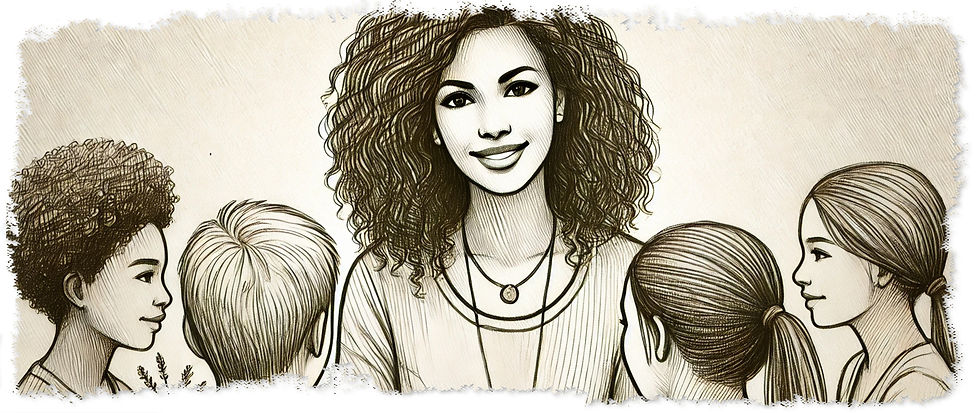The Power of Perspective: How a Positive Mindset in Teaching Improves Student Behavior
- Roshanda Glenn

- Aug 26
- 4 min read
Updated: Sep 27

If you’ve ever stood in front of your class while one of your students was having a major meltdown, with your heart pounding and mind racing, wondering how you were going to pull everyone back from the edge, you know this truth: managing extreme behaviors isn’t just about strategies.
It’s about mindset.
A positive mindset in teaching shapes the way we see our students..
It colors the tone of our voice, the words we choose, and the way we carry ourselves in the moment. The right mindset doesn’t erase hard behaviors, but it does give us the strength to handle them with care, calm, and confidence.
When we meet challenges with empathy, patience, and belief in our students’ potential, something shifts.
The classroom becomes less about control and more about connection; less about punishment and more about growth.
Today, I want to walk you through ten mindset shifts that can help you strengthen a positive mindset in teaching so you can stay steady in the storm and create the kind of classroom where your students know they are safe, valued, and capable of change.
1. Begin with Empathy
Think about what it feels like to be misunderstood. For many of our students, extreme behaviors are their way of saying, “I don’t know how else to tell you what I need.”
When we pause and step into their shoes - even for just a moment - we see more than the outburst.
We see the child.
Empathy softens our response and builds the trust that makes change possible.

2. Choose Growth Over Perfection
Every meltdown, every power struggle, every slammed door is also an opportunity.
A growth mindset reminds us that neither students nor teachers are finished products. All of us are learning and, at times, stumbling forward.
When we treat ours and our students' mistakes as stepping-stones, students are able to learn to be confident and resilient by watching us model these traits for them.
3. Hold High Expectations with a Gentle Hand
Our students rise up - or fall down - to the level of the beliefs we hold about them.
Even the toughest kids notice when we’ve lowered the bar.
High expectations paired with compassion communicate to our students, “I know you can do this, and I’ll walk with you until you do.” That balance of firmness and care sets the stage for growth.

4. Stay Calm When the Heat Rises
Your calm is contagious. Students borrow it when their own feelings of calm and control feel out of reach.
It doesn’t mean you won’t feel frustrated or afraid in the moment - you’re human.
But taking a breath, grounding yourself, or simply lowering your voice models self-control in a way lectures never could.
5. Build Your Resilience
This work will stretch you. There will be days when you feel drained. But resilience is built one comeback at a time.
Remember past challenges that you’ve survived, lean on lessons you’ve learned, and remind yourself that tomorrow is another chance to try again.

6. Invest in Relationships Daily
Before behavior can change, trust has to be there.
Students need to know you like them on their good days and love them through their bad ones.
Small daily gestures like asking about their weekend, noticing their effort, or sharing a smile stack up and form the bridge that carries you both through hard times.
7. Practice Patient Persistence
Progress with behavior is rarely quick or neat. In fact, some days you’ll wonder if you’re moving backward.
Patience says, “I’ll still be here tomorrow, and the day after, and the day after that.” That consistency is the steady heartbeat students need when their own heart (and life) feel unsteady.

8. Reflect with Honesty and Grace
After the storm has passed, give yourself permission to reflect without judgment. Ask:
"What went well?"
"What could I try differently next time?"
Reflection isn’t about beating yourself up, it’s about giving yourself the same grace you give your students.
9. Look for the Next Step Forward
When the dust settles, don’t stay stuck in what went wrong. Shift your focus to solutions.
What small step can move things in the right direction?
A solution-oriented mindset lifts you and your students out of the problem and into possibility.

10. Lean on Your Village
You weren’t meant to carry this work alone. Reach out to a trusted teammate, administrator, counselor, or friend.
Collaboration doesn’t just bring new strategies, it brings hope.
There’s comfort in remembering that you are part of a community of educators all pulling toward the same goal: helping kids succeed.
The Ongoing Power of a Positive Mindset in Teaching
Building a positive mindset in teaching is never finished.
Every day we walk into our classrooms, we get another chance to choose empathy over judgment, patience over frustration, and growth over giving up.
And here’s the best part: when we change our mindset, our students feel it.
They lean into our calm. They rise to meet our belief in them. They start to imagine themselves as more than the sum of their mistakes. That’s the power of a teacher’s mindset. It doesn’t just change behavior.
It changes lives.
Want more strategies like this?
Subscribe to Project Behavior Change! and get weekly tips, update on Behavior Blueprints, and early access to workshops and trainings - delivered straight to your inbox.
Until next time...





Comments